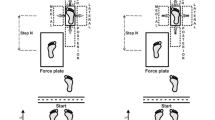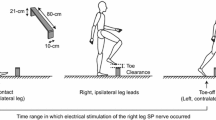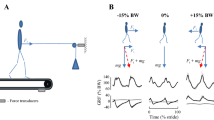Abstract.
The goal of this study was to investigate changes of H-reflex amplitudes during a motor learning task. Subjects with reduced vision were instructed to step over an obstacle on a treadmill as low as possible, while the soleus H-reflex was elicited. Acoustic warning and feedback signals about performance were provided. Performance improvement was associated with a decrease of muscle activity, needed to step over the obstacle (rectus femoris, biceps femoris, tibialis anterior and gastrocnemius medialis muscles), and of foot clearance, while joint angle trajectories from knee and ankle became more stable. The experiment consisted of five runs, three with normal treadmill walking and two with randomly stepping over the obstacle (100 times). H-reflexes were elicited at early and late stance phase before stepping over the obstacle. H/M ratio, latency and duration were determined. The values of these measures were calculated for the onset and end of a run and their course over time was evaluated using a correlation coefficient. The largest adaptations with a significant increase of reflex amplitude occurred during the first obstacle run. This increase lasted only briefly and the reflex amplitudes decreased to their previous values. During the later obstacle run, no H-reflex modulation occurred. It is concluded that a motor learning task causes adaptational effects not only on performance, but also on H-reflex responses. The results indicate that most of the modulation of H-reflexes is probably due to supraspinal influences on reflex transmission. The observations made are probably less specific for this motor task (stepping over the obstacle), but rather associated with the increased attention required by the motor learning task during the first obstacle run.




Similar content being viewed by others
References
Anstis S (1995) Aftereffects from jogging. Exp Brain Res 103:476–478
Chen XY, Wolpaw JR (1995) Operant conditioning of H-reflex in freely moving rats. J Neurophysiol 73:411–415
Chen XY, Wolpaw JR (1997) Dorsal column but not lateral column transection prevents down conditioning of H-reflex in rats. J Neurophysiol 78:1730–1734
Chen XY, Chen L, Wolpaw JR (2000) The corticospinal tract in development and maintenance of H-reflex operant conditioning in rats. J Soc Neurosci Abstr 26:2206
De Leon RD, Hodgson JA, Roy RR, Edgerton VR (1998) Locomotor capacity attributable to step training versus spontaneous recovery after spinalization in adult cats. J Neurophysiol 79:1329–1340
Dietz V (1997) Neurophysiology of gait disorders: present and future applications. Electroencephalogr Clin Neurophysiol 103:333–355
Dietz V, Colombo G, Jensen L (1994) Locomotor activity in spinal man. Lancet 344:1260–1263
Dietz V, Colombo G, Jensen L, Baumgartner L (1995) Locomotor capacity of spinal cord in paraplegic patients. Ann Neurol 37:574–582
Edgerton VR, Roy RR, Hodgson JA, Prober RJ, De Guzman CP, De Leon R (1992) Potential of adult mammalian lumbosacral spinal cord to execute and acquire improved locomotion in the absence of supraspinal input. J Neurotrauma 9 (Suppl 1):S119–S128
Erni T, Colombo G (1998) Locomotor training in paraplegic patients: a new approach to assess changes in leg muscle EMG patterns. Electroencephalogr Clin Neurophysiol 109:135–139
Erni T, Dietz V (2001) Obstacle avoidance during human walking: learning rate and cross-modal transfer. J Physiol 534:303–312
Evatt ML, Wolf SL, Segal RL (1989) Modification of human spinal stretch reflexes: preliminary studies. Neurosci Lett 105:350–355
Meyer-Lohmann J, Christakos CN, Wolf H (1986) Dominance of the short-latency component in perturbation induced electromyographic responses of long-trained monkeys. Exp Brain Res 64:393–399
Myklebust BM, Gottlieb GL, Agarwal GC (1986) Stretch reflexes of the normal human infant. Dev Med Child Neurol 28:440–449
Nielsen J, Crone C, Hultborn H (1993) H-reflexes are smaller in dancers from the Royal Danish Ballet than in well-trained athletes. Eur J Appl Physiol 66:116–121
Patla AE, Prentice SD (1995) The role of active forces and intersegmental dynamics in the control of limb trajectory over obstacles during locomotion in humans. Exp Brain Res 106:499–504
Patla AE, Vickers JN (1997) Where and when do we look as we approach and step over an obstacle in the travel path? Neuroreport 8:3661–3665
Prokop T, Berger W, Zijlstra W, Dietz V (1995) Adaptational and learning processes during human split-belt locomotion: interaction between central mechanisms and afferent input. Exp Brain Res 106:449–456
Segal RL (1997) Plasticity in the central nervous system: operant conditioning of the spinal stretch reflex. Top Stroke Rehabil 3:76–87
Van Hedel HJA, Biedermann M, Erni T, Dietz V (2002) Obstacle avoidance during human walking: transfer of motor skill from one leg to the other. J Physiol 543:709–717
Wolpaw JR (1997) The complex structure of a simple memory. Trends Neurosci 20:588–594
Wolpaw JR, Dowman R (1988) Operant conditioning of primate spinal reflexes: effect on cortical SEPs. Electroencephalogr Clin Neurophysiol 69:398–401
Wolpaw JR, O'Keefe JA (1984) Adaptive plasticity in the primate spinal stretch reflex: evidence for a two-phase process. J Neurosci 4:2718–2724
Wolpaw JR, Tennissen AM (2001) Activity-dependent spinal cord plasticity in health and disease. Annu Rev Neurosci 24:807–843
Wolpaw JR, Braitman DJ, Seegal RF (1983) Adaptive plasticity in the primate spinal stretch reflex: initial development. J Neurophysiol 50:1296–1311
Zehr EP, Stein RB (1999) What functions do reflexes serve during human locomotion? Prog Neurobiol 58:185–205
Acknowledgements.
We thank C. Bastiaanse, I. Pappas, T. Keller and G. Colombo for their technical help. This work was supported by grants from the Swiss National Science Foundation (nos. 31-62025.00 and 31-64792.01).
Author information
Authors and Affiliations
Corresponding author
Rights and permissions
About this article
Cite this article
Hess, F., van Hedel, H.J.A. & Dietz, V. Obstacle avoidance during human walking: H-reflex modulation during motor learning. Exp Brain Res 151, 82–89 (2003). https://doi.org/10.1007/s00221-003-1415-7
Received:
Accepted:
Published:
Issue Date:
DOI: https://doi.org/10.1007/s00221-003-1415-7




